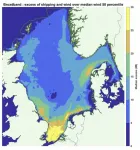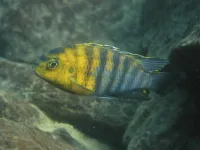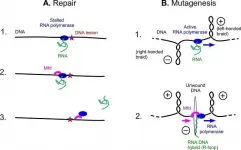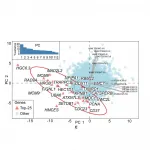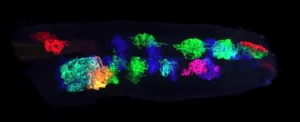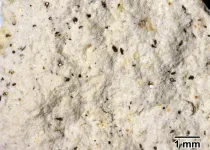(Press-News.org) Travel and economic slowdowns due to the COVID-19 pandemic combined to put the brakes on shipping, seafloor exploration, and many other human activities in the ocean, creating a unique moment to begin a time-series study of the impacts of sound on marine life.
A community of scientists has identified more than 200 non-military ocean hydrophones worldwide and hopes to make the most of the unprecedented opportunity to pool their recorded data into the 2020 quiet ocean assessment and to help monitor the ocean soundscape long into the future. They aim for a total of 500 hydrophones capturing the signals of whales and other marine life while assessing the racket levels of human activity.
Combined with other sea life monitoring tools and methods such as animal tagging, the work will help reveal the extent to which noise in "the Anthropocene seas" impacts ocean species.
Sound travels far in the ocean, and a hydrophone can pick up low-frequency signals from hundreds, even thousands of kilometres away. The highest concentrations of non-military hydrophones are along the North American coasts -- Atlantic, Pacific and Arctic -- Hawaii, Europe, and Antarctica, with some scattered through the Asia-Pacific region.
For over a century, navies have used sound to reveal submarines and underwater mines and for other national security purposes. Marine animals likewise use sound and natural sonar to navigate and communicate across the ocean.
But the effects of human-generated ocean sounds on marine life remain poorly understood.
"Measuring variability and change in ambient, or background, ocean sound over time forms the basis for characterizing marine 'soundscapes,'" says collaborator Peter L. Tyack, Professor of Marine Mammal Biology at the University of St Andrews, Scotland.
"Assessing the risks of underwater sound for marine life requires understanding what sound levels cause harmful effects and where in the ocean vulnerable animals may be exposed to sound exceeding these levels. Sparse, sporadic deployment of hydrophones and obstacles to integrating the measurements that are made have narrowly limited what we confidently know."
In 2011, concerned experts began developing the International Quiet Ocean Experiment (IQOE), launched in 2015 with the International Quiet Ocean Experiment Science Plan. Among their goals: create a time series of measurements of ambient sound in many ocean locations to reveal variability and changes in intensity and other properties of sound at a range of frequencies.
The plan also included designating 2022 "the Year of the Quiet Ocean."
Due to COVID-19, however, "the oceans are unlikely to be as quiet as during April 2020 for many decades to come," says project originator Jesse Ausubel, Director of the Program for the Human Environment at The Rockefeller University.
"The COVID-19 pandemic provided an unanticipated event that reduced sound levels more than we dreamed possible based on voluntary sound reductions. IQOE will consider 2020 the Year of the Quiet Ocean and is focusing project resources to encourage study of changes in sound levels and effects on organisms that occurred in 2020, based on observations from hundreds of hydrophones deployed by the worldwide ocean acoustics community in 2019-2021."
With IQOE encouragement, the number of civilian hydrophones operating in North America, Europe, and elsewhere for research and operational purposes has increased dramatically. With these, IQOE and the ocean sound research community can shed needed light on humans' influences on marine life and ecosystems.
The existing hydrophone network covers shallow coastal and shelf areas most influenced by local changes in human activity. It also includes deep stations that can measure the effects of low-frequency sound sources over large open ocean areas.
Of the 231 non-military hydrophones identified to February 2021, several have agreed to their geographic coordinates and other metadata being shown on the IQOE website, with organizers hoping to attract many more contributors.
Of the hydrophones identified, most are in US and Canadian waters, with increasing numbers elsewhere, particularly in Europe. Meanwhile, more acoustic instrumentation and measurements are clearly needed across the Southern Hemisphere.
The researchers are working to create a global data repository with contributors using standardized methods, tools and depths to measure and document ocean soundscapes and effects on the distribution and behavior of vocalizing animals.
As part of the effort to create a global time-series, new software under development by a team of researchers across the country and led by the University of New Hampshire (MANTA) will soon help standardize ocean sound recording data from collaborators, facilitating its comparability, pooling and visualization.
On April 8, the new MANTA software will be available at END
Year of the quiet ocean: Emerging ocean listening network will study seas uniquely quieted by COVID
Amid COVID pause in marine activities, growing network aims to monitor soundscapes, assess changes in behavior of marine life; More than 200 widely-distributed non-military hydrophones already listening
2021-04-08
ELSE PRESS RELEASES FROM THIS DATE:
How did 500 species of a fish form in a lake? Dramatically different body clocks
2021-04-08
Animals are remarkably diverse in their sleep and activity patterns due to foraging strategies, social behavior and their desire to avoid predators. With more than 3,000 types of cichlids, these freshwater fish may just be one of the most diverse species in the world. Lake Malawi alone, which stretches 350 miles through eastern Africa, is home to more than 500 cichlid species. They evolved from a few species that likely entered the lake about 3 million years ago and now display very different behaviors and inhabit well-defined niches throughout ...
Excellent outcomes reported for first targeted therapy for pediatric Hodgkin lymphoma
2021-04-08
Scientists are reporting results of the first frontline clinical trial to use targeted therapy to treat high-risk pediatric Hodgkin lymphoma. The study showed that the addition of brentuximab vedotin achieved excellent outcomes, reduced side effects, and allowed for reduced radiation exposures.
The study was the result of work by a multi-site consortium dedicated to pediatric Hodgkin-lymphoma. Collaborating institutions include St. Jude Children's Research Hospital, Stanford University School of Medicine, Dana-Farber Cancer Institute, Massachusetts General Hospital, Maine Children's Cancer Program and OSF Children's Hospital of Illinois.
A paper detailing the findings was published today in ...
A protein with a dual role: Both repair and mutation
2021-04-08
The Mfd protein repairs bacterial DNA, but can also, to scientists' surprise, promote mutation.
Bacterial mutations can lead to antibiotic resistance.
Understanding this second "role" of the Mfd protein opens up opportunities for combating antibiotic resistance, and also the resistance of tumours to anti-cancer drugs and therapies.
Using a specialized protein, all bacteria are capable of rapidly and effectively repairing damage to their DNA from UV. However, this mutation frequency decline (Mfd) protein plays another role and causes mutations. A team involving ...
Scientists at IRB Barcelona identify a potential target to treat lung cancer
2021-04-08
In cancer, personalised medicine takes advantage of the unique genetic changes in an individual tumour to find its vulnerabilities and fight it. Many tumours have a higher number of mutations due to a antiviral defence mechanism, the APOBEC system, which can accidentally damage DNA and cause mutations.
Researchers at IRB Barcelona led by Dr. Travis Stracker and Dr. Fran Supek have found the HMCES enzyme to be the Achilles heel of some lung tumours, specifically those with a higher number of mutations caused by the APOBEC system.
"We have discovered that blocking HMCES is very damaging to cells with an activated ...
Hispanic immigrants of working age at highest risk of dying from COVID-19
2021-04-08
Hispanic immigrants of working age -- 20 to 54 years old -- are over 11 times more likely to die of COVID-19 than U.S.-born men and women who are not Hispanic, according to a USC study of California death certificate data from 2020.
The study, published Monday in the END ...
Carbon dots from human hair boost solar cells
2021-04-08
QUT researchers have used carbon dots, created from human hair waste sourced from a Brisbane barbershop, to create a kind of "armour" to improve the performance of cutting-edge solar technology.
In a study published in the Journal of Materials Chemistry A, the researchers led by Professor Hongxia Wang in collaboration with Associate Professor Prashant Sonar of QUT's Centre for Materials Science showed the carbon nanodots could be used to improve the performance of perovskites solar cells.
Perovskites solar cells, a relatively new photovoltaic technology, are seen as the best PV candidate to deliver low-cost, highly efficient solar electricity in coming years. ...
Oregon researchers identify pathway that transitions brain from plasticity to stability
2021-04-08
EUGENE, Ore. -- April 8, 2021 -- Researchers exploring the developing central nervous system of fruit flies have identified nonelectrical cells that transition the brain from highly plastic into a less moldable, mature state.
The cells, known as astrocytes for their star-like shapes, and associated genes eventually could become therapeutic targets, said University of Oregon postdoctoral researcher Sarah Ackerman, who led the research.
"All of the cell types and signaling pathways I looked at are present in humans," Ackerman said. "Two of the genes that I ...
Third of Antarctic ice shelf area at risk of collapse as planet warms
2021-04-08
More than a third of the Antarctic's ice shelf area could be at risk of collapsing into the sea if global temperatures reach 4°C above pre-industrial levels, new research has shown.
The University of Reading led the most detailed ever study forecasting how vulnerable the vast floating platforms of ice surrounding Antarctica will become to dramatic collapse events caused by melting and runoff, as climate change forces temperatures to rise.
It found that 34% of the area of all Antarctic ice shelves - around half a million square kilometres - including 67% of ice shelf area on the Antarctic Peninsula, would be at risk of destabilisation under 4°C of warming. Limiting temperature ...
IU School of Medicine researchers develop blood test for depression, bipolar disorder
2021-04-08
INDIANAPOLIS--Worldwide, 1 in 4 people will suffer from a depressive episode in their lifetime.
While current diagnosis and treatment approaches are largely trial and error, a breakthrough study by Indiana University School of Medicine researchers sheds new light on the biological basis of mood disorders, and offers a promising blood test aimed at a precision medicine approach to treatment.
Led by Alexander B. Niculescu, MD, PhD, Professor of Psychiatry at IU School of Medicine, the study was published today in the high impact journal Molecular Psychiatry . The work builds on previous research conducted by Niculescu and his colleagues into blood biomarkers that track suicidality as well as pain, post-traumatic stress ...
Asteroid crater on Earth provides clues about Martian craters
2021-04-08
The almost 15-million-year-old Nördlinger Ries is an asteroid impact crater filled with lake sediments. Its structure is comparable to the craters currently being explored on Mars. In addition to various other deposits on the rim of the basin, the crater fill is mainly formed by stratified clay deposits. Unexpectedly, a research team led by the University of Göttingen has now discovered a volcanic ash layer in the asteroid crater. In addition, the team was able to show that the ground under the crater is sinking in the long term, which provides important ...
LAST 30 PRESS RELEASES:
Autonomous AI agents developed to detect early signs of cognitive decline
Study finds ocean impacts nearly double economic cost of climate change
Increased deciduous tree dominance reduces wildfire carbon losses in boreal forests
Researchers discover how a respiratory bacterium obtains essential lipids from the human body and targets fat-rich tissues
Locust swarms destroy crops. Scientists found a way to stop that
More resources and collaboration needed to support prevention and treatment of obesity
Two types of underconfidence linked to anxiety and gender
Insects are victims too: Global study shows impacts of invasive alien species on populations
Pioneering natural, degradable polymer capsules
Forestry is becoming digital and automated
Maternity baby deaths much higher in northern England than in the South
Mosquitoes’ thirst for human blood has increased as biodiversity loss worsens
The stop-smoking medication varenicline may also work for cannabis use disorder
Potential new treatment for sepsis
Study reveals how many hours of video games per week might be too many
Electrospinning for mimicking bioelectric microenvironment in tissue regeneration
Home fingertip oxygen monitors less accurate for people with darker skin tones
Six weeks in a cast no less effective than surgery for unstable ankle fractures
Precautionary approach to alcohol-free and low alcohol drinks needed to protect public health, say experts
Gas-atomized Ca–Mg alloy powders produce hydrogen simply by adding water — high-efficiency hydrogen generation at room temperature
British redcoat’s lost memoir reveals harsh realities of life as a disabled veteran
World-leading rare earth magnet recycling facility launches in UK
Corday Selden selected for the Oceanography Society Early Career Award
MIT chemists determine the structure of the fuzzy coat that surrounds Tau proteins
Same moves, different terrain: How bacteria navigate complex environments without changing their playbook
Severe weather is deadly for vulnerable older adults long after the storm ends, study finds
Expert panel highlights opportunities for improving cancer studies
Hearing aid prescriptions not associated with changes in memory and thinking
Seth Zippel selected for The Oceanography Society Early Career Award
Jeremy Horowitz selected for The Oceanography Society Early Career Award
[Press-News.org] Year of the quiet ocean: Emerging ocean listening network will study seas uniquely quieted by COVIDAmid COVID pause in marine activities, growing network aims to monitor soundscapes, assess changes in behavior of marine life; More than 200 widely-distributed non-military hydrophones already listening
